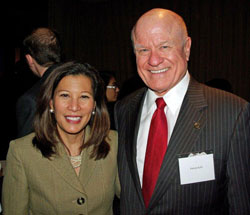Courts operate in ‘crisis
mode’ under governor’s budget
By Laura Ernde
Staff Writer
 |
Chief Justice Tani Cantil-Sakauye and State Bar President Patrick Kelly
|
California’s
court system escaped additional operational cuts in Gov. Jerry Brown’s proposed
2013-14 budget, but that bit of good news was tempered by the reality of
continued courtroom closures and reduced services across the state.
In a
conference call with reporters last month, Chief Justice Tani Cantil-Sakauye
said the budget news was on one level a relief. Brown did not eliminate trial
court reserves earlier than expected, a proposal that court leaders said would
have drained $200 million from operations.
Instead the
governor proposed cutting $200 million from court construction projects. Also, because the court operations
budget remained flat, the trial courts will be forced to move forward with
planned courtroom closures and other reductions in service. The branch’s annual budget is $475
million smaller than it was before a series of cuts began four years ago.
In the same
conference call, Administrative Director of the Courts Steven Jahr said families
facing breakups now have to wait three months for a permanent custody and
visitation order in Shasta County Superior Court, where he used to be a judge.
“It has real
human consequences,” he said. “What’s happened over the last three or four
years is not being remedied.”
Two of the
state’s most influential newspapers have written editorials about the impact to
trial courts. See the Los Angeles Times and Sacramento Bee.
The Open
Courts Coalition – which includes State Bar leaders and members of the
plaintiffs’ bar and defense bar – will continue to lobby for the restoration of
court funds, State Bar President Patrick Kelly said.
“Courts are
in a crisis mode and members of the judiciary are our heroes in trying to
maintain access to justice for clients in California,” he said.
The
coalition plans to hold meetings this month to discuss a thorny issue that’s
confounded the judiciary for 15 years – a formula to ensure equal
access to the courts throughout the state.
State Bar
Executive Director Joseph Dunn said state lawmakers first called for those
metrics 15 years ago, when it transferred funding of the judicial branch from
the counties to the state. But despite years of trying, no one has been able to
devise metrics on which everyone can agree.
Last fall, the
governor created a Trial Court Funding Workgroup, with members appointed by the chief
justice and the governor, to evaluate the state’s progress on equal funding
envisioned by the Lockyer-Isenberg Trial Court Funding Act of 1997. The group
has held a series of meetings and is due to report to the governor by April.
Dunn said
unless the bench and bar can come up with a way to measure whether state funding
is ensuring equal access to litigants, it will be difficult to convince the
legislature to restore court funding.